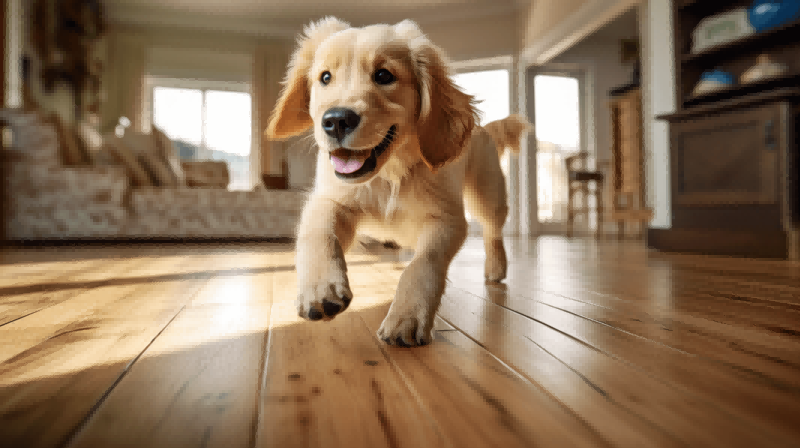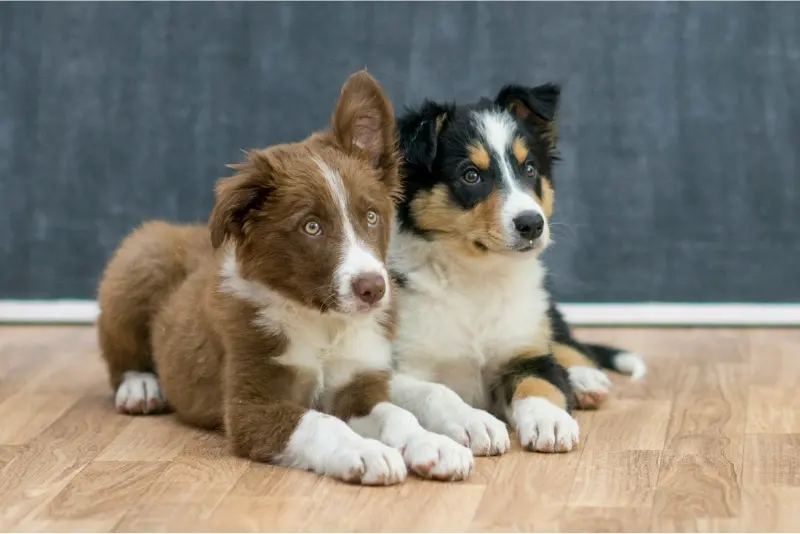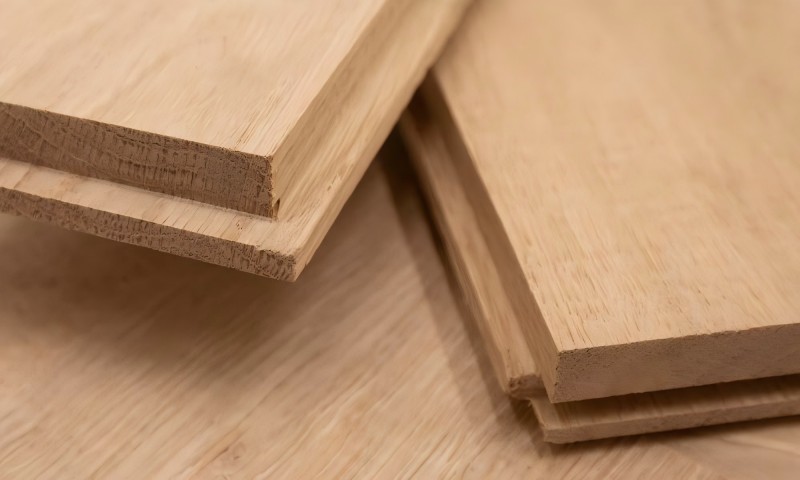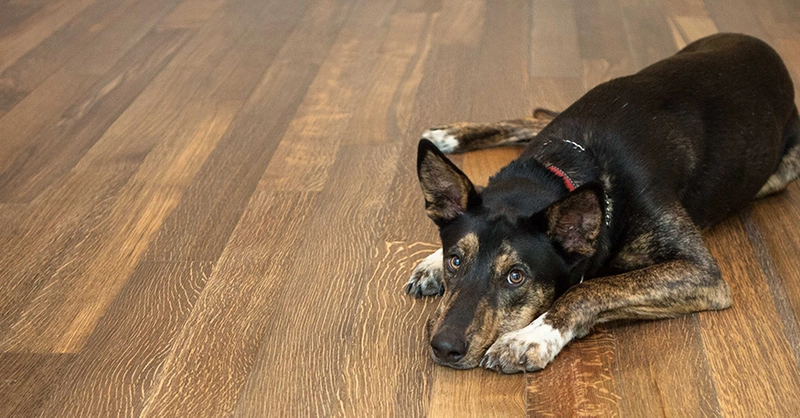For families with dogs, it is difficult to choose the type of floor because they want their dogs to stay at home comfortably, but they don’t want the floor to be damaged by them. Let major provide you with some valuable suggestions.

Table of Contents
ToggleWhat kind of damage can dogs cause to engineered wood flooring?
- Scratches and Dents
- Urine stains and Staining
- Wear and Tear
- Allergen Accumulation
- The noise of claws rubbing against the floor
Scratches and dents
- Nail scratches: Even with regular trimming, a dog’s claws can scratch the top layer of engineered flooring, especially if the finish isn’t scratch-resistant.
- Furniture movement: Dogs can push or knock furniture, leading to dents or scratches in the flooring.
Urine stains and staining
- Accidents: If a dog has accidents on the floor and they aren’t cleaned up promptly, moisture can seep into the seams, causing swelling or warping in the engineered wood layers.
- Water bowls: Spilled water from dog bowls can lead to staining or damage over time if the flooring isn’t water-resistant.
Wear and tear
- High-traffic areas: Dogs tend to wear down high-traffic areas, especially near doors, food bowls, or other places they frequent.
- Playtime: Energetic dogs can cause more wear and tear through running, jumping, or playing indoors.
Allergen accumulation
- Dog hair, dander, and dirt can accumulate in the gaps or on the surface, requiring regular cleaning and potentially affecting the appearance of the floor over time.
Claws rubbing sound
- When dogs run or play on the floor, their nails make clicking or scraping sounds, which is very harsh. They also leave claw marks on the floor, damaging the floor and making it unrecognizable.
What should dog-raising families pay attention to when choosing engineered flooring?

When purchasing engineered flooring as a dog owner, you should focus on features that will help minimize or withstand the damage caused by dogs.
Choose durable wear layer
When choosing engineered flooring for households with pets, it’s essential to prioritize a thick wear layer, preferably 3mm or more. This added thickness offers superior resistance to the scratches and dents commonly caused by dogs’ claws.
Not only does a thicker wear layer extend the lifespan of your flooring, but it also provides the ability to sand and refinish the surface multiple times throughout its life. This means that, even with significant wear and tear over the years, the floor can be restored to its original look without the need for full replacement, making it a cost-effective and durable option for pet owners.
Choose a wear-resistant layer according to different dog sizes:
| Dog Traffic | Wear-Resistant Layer Thickness (mm) |
| Small dogs | 3mm-4mm |
| Medium Dog | 5mm-6mm |
| Large Dogs | 6mm-8mm |
Choose the coating
When purchasing engineered flooring for a dog-friendly home, it’s essential to select a surface coating that can withstand the wear and tear from pets while maintaining the aesthetic appeal of the floor. Durability is important since dogs, especially larger breeds, may be hard on floors.
Here’s a breakdown of surface treatments that help protect against common dog-related damage:
- UV-Cured Finish: This finish is cured using ultraviolet light, making it extremely hard and durable. It offers excellent scratch resistance, which is crucial for dog owners, as it helps to minimize the marks caused by claws. Additionally, it’s easy to clean and maintain, ensuring that any dirt or mess brought in by pets can be quickly wiped away without damaging the surface.
- Aluminum Oxide Coating: This is one of the most durable finishes available for engineered flooring. It makes the floor far more resilient to dents and scratches, which is ideal for houses with active pets. This coating can endure high levels of foot traffic and playtime, offering long-lasting protection against pet-induced damage.
- Oil-Based Finish: An oil-based treatment can be perfect for your flooring if you want it to look more natural. This finish penetrates the wood, giving it a rich appearance. Although it may require more maintenance than other finishes, its main advantage is that small scratches can be spot-repaired, allowing you to maintain the beauty of your floor over time.
- Matte Finish: Unlike glossy finishes, which show every scratch and paw print, a matte finish is better at concealing imperfections. Homes with dogs will find this finish to be an excellent option as it reduces the visibility of minor marks. The floor appears more subdued and contemporary because of the low shine.
- Waterproof Sealing: Water damage can occur in accidents, and having a floor that can withstand it is crucial. Waterproof sealing provides an extra layer of protection against moisture, whether from spills, pet accidents, or water brought in from outside. This treatment ensures that the floor remains intact and doesn’t warp or stain over time.
- Scratch-Resistant Coating: Specifically designed to combat the damage caused by pet claws, this coating strengthens the surface of the floor, preventing scratches and gouges. It’s an ideal solution for dog owners who want to maintain the pristine appearance of their floors without having to worry about frequent repairs or refinishing.
Choose the water-resistant core
When selecting engineered flooring for homes with dogs, it’s essential to choose a product with a water-resistant core. Flooring made with high-density fiberboard (HDF) or similar moisture-resistant materials provides an extra layer of protection against moisture. This core aids in preventing the absorption of liquids, which over time may cause damage, swelling, or warping.
In homes with pets, accidental spills, water from bowls, and pet accidents are common, and having a water-resistant core can significantly extend the life of the flooring. Additionally, this feature ensures the flooring remains structurally sound, maintaining its integrity and appearance even under high-traffic conditions. For dog owners, a water-resistant core is crucial for preserving the durability and longevity of their engineered flooring.
Choose the textured of the flooring
When dogs run or play on the floor, their nails will make clicking or scratching sounds, which is very harsh and will also disturb the neighbors’ rest. You should look for specific textures and finishes designed to provide better grip, hide scratches, and reduce sound.
- Wire-Brushed Finish: The wire-brushed texture improves grip for safer walking, hides small scratches by blending imperfections, and reduces noise by dampening sound and echoes on its slightly rough surface.
- Distressed or Hand-Scraped Finish: The uneven texture of distressed or hand-scraped flooring enhances slip resistance, hides new scratches with its “worn” look, and reduces noise levels by absorbing sound due to its thicker design.
- Matte Finish: Matte finishes are less slippery, conceal small scratches by reflecting less light, and, when combined with thicker underlayments or sound-absorbing cores, effectively reduce impact noise and echoes in the room.
- Textured or Embossed Finish: Textured or embossed finishes provide extra traction for slip resistance, conceal minor scratches and dents, and slightly dampen noise by reducing surface impact sounds, making them ideal for high-traffic areas.
Choose hardwood species
When selecting engineered flooring for dog-raising households, the hardness of the wood species plays a crucial role in durability and resistance to wear and tear. Woods are measured by the Janka hardness scale, which determines their resistance to scratches, dents, and general damage. Here’s how different wood species compare based on their hardness:
- Oak: A popular choice, red oak has a Janka hardness rating of around 1,290, while white oak is even harder, at around 1,360. These woods offer good durability, making them resistant to the scratches and scuffs caused by dogs’ claws.
- Hickory: One of the hardest domestic wood species with a Janka rating of about 1,820, hickory is exceptionally resistant to dents and scratches, making it an excellent option for homes with large or energetic dogs.
- Maple: With a hardness rating of approximately 1,450, maple provides a smooth surface that resists wear and tear, making it both durable and aesthetically pleasing for dog owners.
Select seamless installation
When choosing engineered flooring for homes with pets, the type of floor edge and the fit of the planks are crucial factors in preventing damage and maintaining cleanliness.

- Square Edges: Engineered flooring with square edges creates a seamless, flat surface when installed, with no visible gap between planks. This is ideal for dog owners because it leaves fewer spaces where dirt, pet hair, and moisture can get trapped. The smooth transition between planks also makes it easier to clean and prevents any buildup of allergens or grime.
- Click-Lock Systems and Floating Floors: Flooring with click-lock systems fits tightly together without the need for nails or glue, forming a strong, interlocking surface. This system is popular for floating floors, where planks are laid over the subfloor without being adhered to it. For dog owners, click-lock systems are advantageous because they allow for expansion and contraction without creating gaps that can trap dirt or pet hair. The tight fit also prevents moisture from seeping between planks, reducing the risk of damage from pet accidents or water spills.
Choose eco-friendly and non-toxic options
For dog owners, choosing flooring with low-VOC or zero-VOC finishes reduces the presence of these harmful chemicals in the air, ensuring that the environment remains safe and healthy for your pets. Low-VOC finishes are often made from water-based formulations that emit fewer toxic fumes compared to traditional solvent-based products.
- Natural Oil or Wax Finishes: Flooring treated with natural oil or wax finishes offers a safer, more eco-friendly alternative to synthetic finishes. These finishes penetrate the wood and provide a durable surface without releasing harmful chemicals, making them ideal for homes with pets. In addition to being non-toxic, they can often be spot-repaired, which is helpful in dealing with scratches caused by dogs.
- Choosing FSC-certified flooring supports sustainable practices and ensures that the wood used in your flooring is harvested responsibly.
- GreenGuard Certification: Flooring with GreenGuard certification is tested for low chemical emissions and meets strict standards for indoor air quality. For dog owners, making sure their pups aren’t exposed to dangerous substances is especially crucial.
- Compliance with CARB Phase 2: Flooring that satisfies the formaldehyde emissions guidelines set forth by the California Air Resources Board (CARB) improves indoor air quality. By doing this, formaldehyde levels are certain to be drastically lowered, giving dogs and their owners a healthier environment.
In Conclusion
Dog owners should choose engineered hardwood flooring that balances durability, safety, and ease of maintenance. Select tougher wood species, such as maple, hickory, or oak, as they are more resilient to dents and abrasion from canine claws. Prioritize textured or matte finishes for better grip, anti-scratch properties, and noise reduction. Tightly fitted planks with minimal gaps and anti-slip surfaces ensure that dirt, moisture, and pet hair don’t get trapped, while eco-friendly, non-toxic options, such as low-VOC finishes and formaldehyde-free materials, safeguard both pets’ health and the environment.

